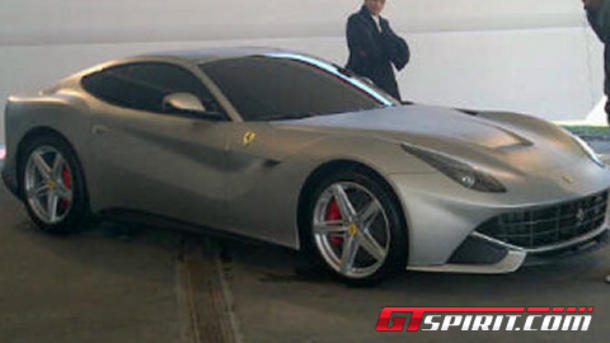The Hurricane: Tomorrow's Holden Reborn
Refugee of trade school shop class lovingly restored by volunteer labor in five-year project
2011-10-18
MELBOURNE - Holden has gone back to the future, restoring its first concept car - the 1969 Holden Hurricane.
The futuristic
research vehicle described as an experiment "to study design trend,
propulsion systems and other long-range developments" has been restored
to its former glory as a labor of love by a dedicated group of Holden
designers and engineers.
Codenamed RD 001, the Hurricane is a mid-engine, rear-wheel drive, two-seat sports car incorporating a remarkable array of innovative features and technology, much of it years ahead of its time.
Features such
as electronic digital instrument displays, station-seeking radio,
automatic temperature control air conditioning, rear-vision camera and
an automated route finder were all showcased in this ground-breaking
vehicle 42 years ago. Many of these technologies have only recently made
their way into mass production, demonstrating Holden's remarkable
foresight into both design and engineering technology.
The Hurricane stole headlines and dropped jaws nationwide when it debuted at the 1969 Melbourne Motor Show.
Michael Simcoe, executive director GMIO Design, said it was fantastic to see such a significant vehicle restored.
"At
Holden we have always prided ourselves on our ability to look into the
future through our concept cars," Simcoe said. "It's amazing to think
that the features we take for granted today were born out of creative
minds over 40 years ago."
As
its code name suggests, the RD 001 was the first product of the GMH
Research and Development organization, staffed by a small squad of
engineers working in conjunction with the Advance Styling Group at the
Fishermans Bend Technical Center in the 1960s.
The
team that designed and built the original Hurricane employed some
advanced technologies and techniques when it came to the powertrain.
Powered by an experimental 4.2-liter (253-cubic-inch) V8, this engine
was a precursor to the Holden V8 engine program which entered production
in late 1969.
The Hurricane's V8 engine featured many advanced design components such as the four-barrel carburettor - a feature
which wouldn't be seen on a production 253ci Holden V8 until the late
1970s. The end result was approximately 262hp (193kW), a towering power
output in 1969 and one that ensured the Hurricane had the go to match
its show.
Perhaps the most innovative features were the "Pathfinder" route guidance system and the rear-view camera.
The
"Pathfinder", essentially a pre-GPS navigation system, relied on a
system of magnets embedded at intersections along the road network to
guide the driver along the desired route. A dash-mounted panel informed the driver of which turn to take by illuminating different arrows, as well as sounding a warning buzzer.
The rear view camera
was also a ground-breaking innovation. Engineers using a closed-circuit
television system with a camera mounted in the rear bumper feeding a
small black-and-white TV mounted in the center console.
Former
Holden Chief Studio Engineer Rick Martin led the modern-day Hurricane
team in researching the vehicle's components, systems and history.
"There
are some genuinely remarkable ideas and technology in the Hurricane,"
Martin said. "From the automatic air-conditioning and magnet-based
guidance system, to the inertia-reel seat belts and metallic paint, this was a car that was genuinely ahead of its time.
"The
hand-picked team of engineers and designers who built the original
Hurricane worked in strict secrecy and began Holden's now proud
tradition of ground-breaking concept cars."
RD
001 stands just 990mm high and has no conventional doors. A
hydraulically powered canopy opens upwards and forward over the front
wheels, combined with twin "astronaut type" power-elevating seats which
rise up and pivot forward, along with the steering column for ease of
access. Occupants are then lowered to a semi-reclining position before
the roof closes over them.
The
wind tunnel-tested fiberglass body consists of three segments; the
canopy, the engine hood and body shell and was finished in an
experimental aluminium flake-based metallic orange paint.
Safety
innovations included a foam-lined fuel tank, integrated roll-over bar,
digital instrument readouts, ignition safety locks, interior padding and
a fire warning system.
The
project to restore RD 001 began in 2006 and has been a genuine labor of
love for some very dedicated Holden designers and engineers
volunteering thousands of hours of their time..
Paul
Clarke, Holden's manager for Creative Hard Modelling, has been largely
responsible for managing the restoration. He ensured as many of the
original parts as possible have been used or remade using modern
techniques to 1969 specification.
"The
entire team has done a fantastic job in bringing this beautiful concept
back to life," Clarke said. "The Hurricane plays a crucial role in
Holden's story and the company has such a great sense of history and
heritage that it was very important to bring RD 001 back to life. It's
been a challenging but incredibly rewarding process."
Since
the debut of the Hurricane in 1969, Holden has built a global
reputation for envisioning and executing world-class concept vehicles.
Holden is recognized globally within General Motors as a center of excellence for concept vehicle and show car development and is one of only three GM design studios capable of designing and building concept cars.
Design executive Simcoe added
that the Hurricane holds a special place in Holden's history as it
kick-started Holden's long love affair with concepts that has since seen
the likes of the iconic GTR-X, Torana TT36, Coupe 60, the GMC Denali XT
(requested specifically by GM for the North American market) and the
award-winning EFIJY.
The Holden Hurricane will be on display to the public at the Motorclassica, car show at the Melbourne Royal Exhibition Building from October 21-23.
![[Photos: Ron Galella/WireImage; Frederick M. Brown/Getty Images]](http://l.yimg.com/bt/api/res/1.2/ccewEWkA7YgRvj8vFcRXsQ--/YXBwaWQ9eW5ld3M7cT04NTt3PTYxMA--/http://media.zenfs.com/en/blogs/ymusic-heard/michael-bolton-touring-1992-red-carpet-2010-photo-split.jpg) [Photos: Ron Galella/WireImage; Frederick M. Brown/Getty Images]
[Photos: Ron Galella/WireImage; Frederick M. Brown/Getty Images]![[Photo: Ebet Roberts/Redferns, Jason Merritt/Getty Images]](http://l.yimg.com/bt/api/res/1.2/U.PNJLc_1rYvVukNIEHU_Q--/YXBwaWQ9eW5ld3M7cT04NTt3PTYxMA--/http://media.zenfs.com/en/blogs/ymusic-heard/bon-jovi-portrait-young-1982-red-carpet-grammys-2010-photo-split.jpg) [Photo: Ebet Roberts/Redferns, Jason Merritt/Getty Images]
[Photo: Ebet Roberts/Redferns, Jason Merritt/Getty Images]![[Photos: Peter Still/Getty Images; Jamie McCarthy/Getty Images]](http://l.yimg.com/bt/api/res/1.2/3.EpipVXFQOaWxcQOeaOIg--/YXBwaWQ9eW5ld3M7cT04NTt3PTYxMA--/http://media.zenfs.com/en/blogs/ymusic-heard/bono-live-aid-1985-red-carpet-2011-photo-split.jpg) [Photos: Peter Still/Getty Images; Jamie McCarthy/Getty Images]
[Photos: Peter Still/Getty Images; Jamie McCarthy/Getty Images]![[Photos: Jeff Kravitz/FilmMagic; Rick Diamond/Getty Images]](http://l.yimg.com/bt/api/res/1.2/.0KKDJlmJkY8v9NBwYosHQ--/YXBwaWQ9eW5ld3M7cT04NTt3PTYxMA--/http://media.zenfs.com/en/blogs/ymusic-heard/billy-ray-cyrus-grammy-1993-im-american-disney-tv-2011-photo-split.jpg) [Photos: Jeff Kravitz/FilmMagic; Rick Diamond/Getty Images]
[Photos: Jeff Kravitz/FilmMagic; Rick Diamond/Getty Images]![[Right photo: Michael Tran/Getty Images]](http://l.yimg.com/bt/api/res/1.2/9MH4UqAqDicFo9rJLbZWYA--/YXBwaWQ9eW5ld3M7cT04NTt3PTYxMA--/http://media.zenfs.com/en/blogs/ymusic-heard/lionel-richie-1991-kennedy-center-honors-2011-photo-split.jpg) [Right photo: Michael Tran/Getty Images]
[Right photo: Michael Tran/Getty Images]














